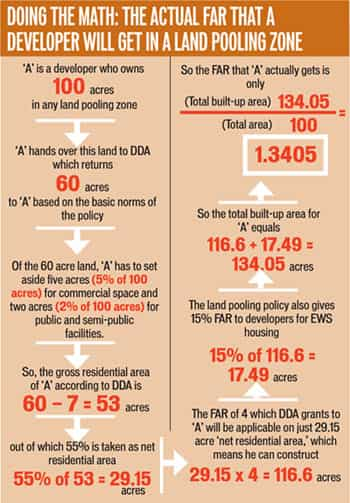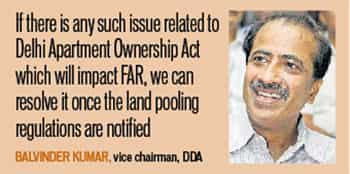Delhi Apartment Ownership Act is likely to make DDA's land pooling policy unattractive to developers
The provisions of Delhi Apartment Ownership Act are likely to make DDA's land pooling policy unattractive to developers
This is one issue which needs the urgent attention of all stakeholders in the land pooling scheme – be they Delhi Development Authority (DDA), developers, prospective homebuyers or investors.

Despite laying down norms for land use distribution and development, DDA’s land pooling policy, notified on September 5, 2013, does not seem to take into account provisions of the Delhi Apartment Ownership Act, 1986. This is obvious from the basic provisions of the scheme, especially for floor area ratio (FAR - saleable built-up area), which looks very attractive on paper but has no clarity on a number of issues which can come in the way of the policy’s implementation.
According to DDA, developers will get a FAR of 4 in zones demarcated for land pooling, but going by calculations and the Apartment Ownership Act – what will finally come to them is just 1 to 1.3 FAR, which is much less than what DDA is claiming to offer.

While fixing FAR for the land pooling policy, DDA had made it attractive for the builders by including community and commercial facilities in the area (part of FAR) they would be developing and selling. However, according to the Delhi Apartment Ownership Act, 1986, the community and commercial facilities have to be handed over by the builders to the residents’ welfare association after the project is completed and cannot be sold.
Section 3(J) of the Act, which defines “common areas and facilities” in a multi-storey building makes it clear that parking areas, shopping centres, schools and storage spaces are part of common areas and facilities. Interestingly, Section 3 (j) (vii) also defines common areas and facilities as “such other community and commercial facilities as may be prescribed.”
This 3 (j) (vii) has been further elaborated in Section 3 of The Delhi Apartment Ownership Rules, 1987, which states that “The other common areas and facilities in terms of sub clause (vii) of clause (j) of Section 3 shall be such areas and facilities which are provided on the land earmarked for apartments…” This means that all other facilities that become a part of common area are: “(i) Children’s playing areas, swimming pools, tennis courts, badminton courts, areas providing for other sports facilities; (ii) community halls for use of apartment owners for marriages or other social functions; (iii) areas available for common use of the apartment owners, forming part of the sanctioned plan, under the bye-laws of the authority; and (iv) any additional space not counted in the permissible floor space shall also be treated as common areas.”

According to the legal provision, thus, developers have to declare as ‘common areas and facilities’ all the areas mentioned above in the deed (instrument through which developers give rights of apartments to buyers) of an apartment. A certified copy of the deed will also have to be given by the developer to the competent authority, ie DDA.
The last stage of a realty transaction in a housing project is execution of the deed, when all facilities are in place, it is very important to have clarity on the pooling policy as it impacts the whole FAR issue, says Amit Jain, whose NGO, Centre for Research and Analysis of Real Estate in India has bought land in the land pooling zone.
“If in DDA’s scheme, community and commercial facilities are part of FAR (saleable built- up area), then developers will assume they will be able to utilise more FAR than what will actually be available for them if the Apartment Ownership Act is factored in. This is the whole problem. DDA must clarify to all stakeholders that the developer can’t sell community and commercial facilities. The only saleable built-up area is the apartment in the group housing project.”

A legal officer from DDA’s legal cell throws light on the matter, saying, “According to the Delhi Apartment Ownership Act, except for apartments, everything else in a project is included as its common areas and facilities with an apartment owner getting undivided interest in the same. It’s very clear that the developer can’t sell any facility to anybody.” The official also admitted that the issue had “missed the attention” of DDA officials calculating FAR to be allocated to developers as per the policy.
Investors and developers who have invested in land pooling zones say that if DDA makes things clear at this initial stage, the developers will include the construction and land costs in the price of the apartment and make sure there are no disputes over the matter later.
A blueprint for land pooling
What is land pooling policy?
Under the land pooling policy, the land parcels owned by individuals or a group of owners are legally consolidated, via transfer of ownership rights to the designated land pooling agency which later transfers the ownership back to the land owners. These land owners are then entrusted with the development of such areas.
Why has DDA introduced the land pooling policy in Delhi in the proposed ‘urbanisable’ areas?
According to DDA, land acquisition and planned development has not kept pace with the increasing demand of urbanisation during the last five decades. Moreover, the process of acquisition is being increasingly challenged by land owners due to low compensation as compared to the market value. So in the land pooling policy either the developers buy land from farmers at the market rate and hand it over to DDA or the farmers can themselves become developers by tying up with construction companies. This will avert land acquisition complications.
How much land will a developer get back from DDA?
According to the DDA’s land pooling model, there are two categories of land pooling – (i) if the developer owns 20 or more than 20 hectare of land, DDA will return 60% of land to him and retain 40%.
(II) If the developer’s land parcel measures less than 20 hectare, DDA will return 48% of land and retain 52%
Zones which will be a part of the policy
According to the land pooling policy, notified on September, 2013, the immediate urban extension is to be in the zones of J, L, M, N and P (I&II).
How long will it take for the scheme to get operational?
On November 18, 2014, DDA sent the final regulation of the scheme to the Ministry of Urban Development, which has to give its approval for notification. Once the regulations get notified, DDA will invite developers to apply for deposit of land.
What’s the minimum size of the land parcel that a developer must have to participate in the land pooling scheme?
The minimum size of the land parcel that the developer will have to hand over to DDA is five acres.
He can even own various plots of different sizes in the land pooling zones and the consolidated size of the plots should not be less than five acres.
How is land ‘returned’?
According to DDA, whenever it acquires around 60% land from a particular sector of the land pooling zones, it will hold a draw and return land to the developers. It is not necessary that the developer get the same parcel that he handed over to DDA.





